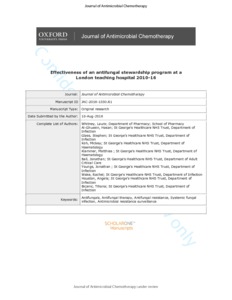Whitney, L; Al-Ghusein, H; Glass, S; Koh, M; Klammer, M; Ball, J; Youngs, J; Wake, R; Houston, A; Bicanic, T
(2019)
Effectiveness of an antifungal stewardship programme at a London teaching hospital 2010–16.
Journal of Antimicrobial Chemotherapy, 74 (1).
pp. 234-241.
ISSN 1460-2091
https://doi.org/10.1093/jac/dky389
SGUL Authors: Bicanic, Tihana
![[img]](https://openaccess.sgul.ac.uk/110169/1.hassmallThumbnailVersion/Whitney%20JAC%20accepted%20version.pdf)  Preview |
|
PDF
Accepted Version
Available under License ["licenses_description_publisher" not defined].
Download (489kB)
| Preview
|
Abstract
Background
The need for antifungal stewardship is gaining recognition with increasing incidence of invasive fungal infection (IFI) and antifungal resistance alongside the high cost of antifungal drugs. Following an audit showing suboptimal practice we initiated an antifungal stewardship programme and prospectively evaluated its impact on clinical and financial outcomes.
Patients and methods
From October 2010 to September 2016, adult inpatients receiving amphotericin B, echinocandins, intravenous fluconazole, flucytosine or voriconazole were reviewed weekly by an infectious diseases consultant and antimicrobial pharmacist. Demographics, diagnosis by European Organization for Research and Treatment of Cancer (EORTC) criteria, drug, indication, advice, acceptance and in-hospital mortality were recorded. Antifungal consumption and expenditure, and candidaemia species and susceptibility data were extracted from pharmacy and microbiology databases.
Results
A total of 432 patients were reviewed, most commonly receiving AmBisome® (35%) or intravenous fluconazole (29%). Empirical treatment was often unnecessary, with 82% having no evidence of IFI. Advice was given in 64% of reviews (most commonly de-escalating or stopping treatment) and was followed in 84%. Annual antifungal expenditure initially reduced by 30% (£0.98 million to £0.73 million), then increased to 20% above baseline over a 5 year period; this was a significantly lower rise compared with national figures, which showed a doubling of expenditure over the same period. Inpatient mortality, Candida species distribution and rates of resistance were not adversely affected by the intervention.
Conclusions
Provision of specialist input to optimize antifungal prescribing resulted in significant cost savings without compromising on microbiological or clinical outcomes. Our model is readily implementable by hospitals with high numbers of at-risk patients and antifungal expenditure.
| Item Type: |
Article
|
| Additional Information: |
This is a pre-copyedited, author-produced version of an article accepted for publication in Journal of Antimicrobial Chemotherapy following peer review. The version of record Laura Whitney, Hasan Al-Ghusein, Stephen Glass, Mickey Koh, Matthias Klammer, Jonathan Ball, Jonathan Youngs, Rachel Wake, Angela Houston, Tihana Bicanic; Effectiveness of an antifungal stewardship programme at a London teaching hospital 2010–16, Journal of Antimicrobial Chemotherapy, Volume 74, Issue 1, 1 January 2019, Pages 234–241 is available online at: https://doi.org/10.1093/jac/dky389 |
| Keywords: |
Microbiology, 1115 Pharmacology And Pharmaceutical Sciences, 0605 Microbiology, 1108 Medical Microbiology |
| SGUL Research Institute / Research Centre: |
Academic Structure > Infection and Immunity Research Institute (INII) |
| Journal or Publication Title: |
Journal of Antimicrobial Chemotherapy |
| ISSN: |
1460-2091 |
| Dates: |
| Date | Event |
|---|
| 1 January 2019 | Published | | 30 October 2018 | Published Online | | 24 August 2018 | Accepted |
|
| Publisher License: |
Publisher's own licence |
| URI: |
https://openaccess.sgul.ac.uk/id/eprint/110169 |
| Publisher's version: |
https://doi.org/10.1093/jac/dky389 |
Statistics
Item downloaded times since 25 Sep 2018.
Actions (login required)
 |
Edit Item |


